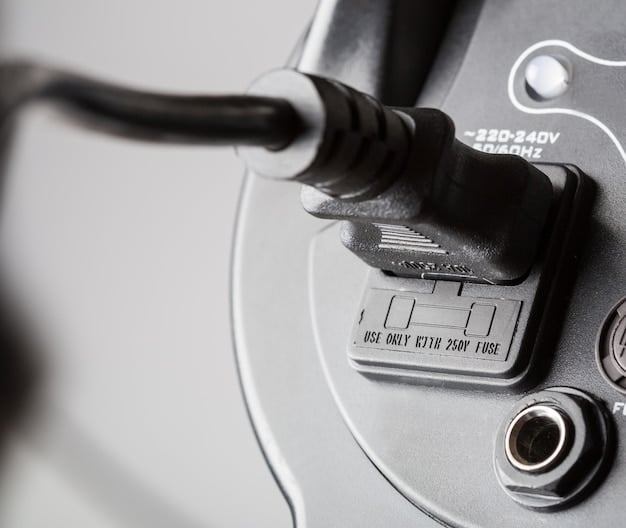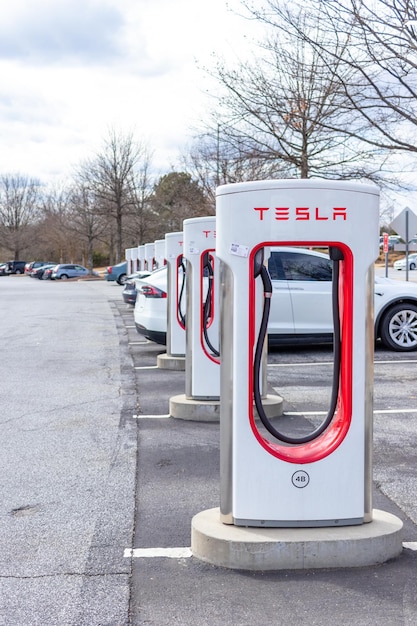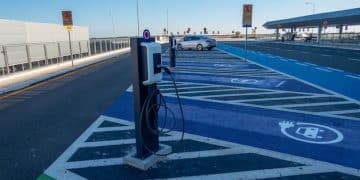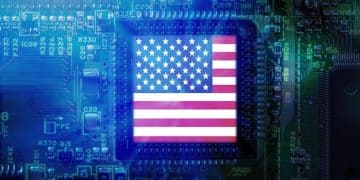Electric Vehicle Fast Charging: US Network Comparison & Expansion

Electric vehicle fast charging networks across the U.S. are rapidly expanding, offering drivers convenient options for quickly replenishing their batteries while on the go, with companies competing to provide wider coverage and faster charging speeds.
As electric vehicles (EVs) become increasingly popular, a robust and accessible charging infrastructure is essential. This article provides a nationwide comparison of electric vehicle fast charging networks in the United States, examining their current coverage and expansion plans to help EV owners make informed decisions about their charging needs and prepare for the future of electric mobility.
Electric vehicle fast charging: understanding the basics
When it comes to electric vehicles, understanding the nuances of charging is crucial. Electric vehicle fast charging, in particular, plays a vital role in making EV ownership convenient, especially for long journeys.
The importance of fast charging
Fast charging stations are designed to deliver a significant amount of power to an EV battery in a relatively short period. This contrasts with Level 1 and Level 2 charging, which are slower and more suitable for overnight or at-home charging.
The speed of DC fast charging can alleviate “range anxiety” and make long-distance travel in an EV more practical.

Different fast charging standards
Several different standards exist for fast charging, each with its own connector type and power output capabilities. Understanding these standards is essential for ensuring compatibility with your EV.
- CHAdeMO: Primarily used by Japanese automakers like Nissan and Mitsubishi, CHAdeMO chargers are declining in popularity in North America.
- CCS (Combined Charging System): This standard combines the J1772 connector for Level 2 charging with a two-pin DC fast charging connector. CCS is widely adopted by many automakers in North America and Europe.
- Tesla Supercharger: Tesla’s proprietary charging network uses a unique connector, but Tesla vehicles can also use CCS chargers with an adapter.
Fast charging technology is continually evolving, with newer chargers offering higher power outputs and faster charging times. The availability and reliability of these stations are also improving as networks expand and invest in infrastructure upgrades.
Understanding the basics of electric vehicle fast charging empowers EV owners to plan their routes effectively and ensures a seamless charging experience on the road.
Comparing major EV fast charging networks in the US
The United States boasts several major electric vehicle fast charging networks, each with its own strengths and areas of coverage. Comparing these networks can help EV owners choose the best options for their needs.
Electrify america
Electrify America is one of the largest and most prominent EV charging networks in the US. Established as part of the Volkswagen settlement, it has invested heavily in building a widespread network of DC fast chargers.
Electrify America stations typically offer multiple charging speeds, with some chargers capable of delivering up to 350 kW, allowing for very fast charging times for compatible vehicles.
Tesla supercharger network
Tesla’s Supercharger network is renowned for its reliability and ease of use. Exclusively available to Tesla owners (with limited access for other EVs at select locations), this network has a significant presence along major highways and urban centers.

Superchargers provide fast and consistent charging speeds, and Tesla continuously upgrades its network with newer, faster chargers.
EVgo
EVgo is another major player in the EV charging market, offering a mix of DC fast chargers and Level 2 chargers. The network focuses on providing charging solutions in urban areas, partnering with retail locations and businesses to offer convenient charging options for EV drivers.
- Coverage: Evaluate network coverage in your frequently traveled areas.
- Charging speeds: Consider the charging speeds offered by each network and compatibility with your EV.
- Pricing: Compare pricing models and membership options.
- Reliability: Research the reliability of each network, considering factors like uptime and customer reviews.
Each network offers unique advantages and disadvantages. By evaluating these factors, EV owners can select the networks that best align with their driving habits and charging requirements.
Expansion plans and future developments
The landscape of electric vehicle fast charging is constantly evolving, with networks announcing ambitious expansion plans and new technologies emerging. Understanding these developments can provide insights into the future of EV charging.
Electrify america’s expansion goals
Electrify America has committed to significantly expanding its charging network in the coming years. The company aims to increase the number of charging stations and improve the availability of ultra-fast chargers across the country.
These expansion plans include strategic investments in underserved areas and the deployment of advanced charging technologies.
Tesla’s supercharger advancements
Tesla continues to enhance its Supercharger network with faster charging speeds and increased station density. The company is also exploring new charging technologies, such as Megachargers for electric semi-trucks.
Tesla’s Supercharger network remains a key competitive advantage, providing Tesla owners with a seamless and reliable charging experience.
Innovations in charging technology
Several innovative charging technologies are on the horizon, promising to further improve the speed and convenience of EV charging.
- Wireless charging: Wireless charging technology eliminates the need for cables, providing a more convenient charging experience.
- Battery swapping: Battery swapping stations allow EV owners to quickly exchange depleted batteries for fully charged ones.
- Ultra-fast charging: Advancements in charging technology are enabling even faster charging speeds.
The electric vehicle fast charging infrastructure is expected to continue to grow and evolve, driven by increasing EV adoption and technological advancements. As these networks expand and new technologies emerge, EV ownership will become even more convenient.
Factors influencing charging network expansion
Several factors influence the expansion of electric vehicle fast charging networks. Understanding these factors can provide insights into the challenges and opportunities facing the industry.
Government incentives and policies
Government incentives and policies play a crucial role in driving the growth of EV charging infrastructure. Tax credits, grants, and regulatory requirements can encourage private investment and accelerate network expansion.
Supportive government policies can create a favorable environment for charging network operators and promote the adoption of electric vehicles.
Private investment and partnerships
Private investment and strategic partnerships are also essential for expanding EV charging infrastructure. Charging network operators often collaborate with retailers, utilities, and automakers to deploy charging stations in optimal locations.
These partnerships can leverage the expertise and resources of various stakeholders to accelerate the development of a comprehensive charging network.
Demand for electric vehicles
The demand for electric vehicles directly influences the expansion of charging networks. As more consumers switch to EVs, the need for accessible and reliable charging infrastructure increases.
- Technology advancements: Improvements in battery technology and charging speeds.
- Government support: Incentives and policies.
- Consumer awareness: Increasing awareness of the benefits of EVs.
The growth of electric vehicle fast charging networks is closely tied to the adoption of electric vehicles. Meeting this demand requires proactive planning and investment in charging infrastructure to support the growing number of EVs on the road.
The impact of charging infrastructure on EV adoption
The availability of robust electric vehicle fast charging infrastructure directly impacts the adoption of EVs. A well-developed charging network can alleviate range anxiety and make EV ownership practical.
Reducing range anxiety
Range anxiety is a significant barrier to EV adoption. A widespread network of fast charging stations can reduce this anxiety by providing EV owners with readily available charging options.
Convenient and reliable charging infrastructure empowers EV owners to travel long distances with confidence.
Encouraging wider EV adoption
The presence of adequate charging infrastructure encourages more consumers to consider purchasing EVs. A comprehensive charging network makes EV ownership more practical and appealing to a broader audience.
- Accessibility: Conveniently located charging stations.
- Reliability: Up-time and maintenance of charging stations.
- Speed: Fast charging speeds.
Investing in electric vehicle fast charging infrastructure is essential for accelerating the transition to electric mobility. By making EV ownership more convenient and practical, a robust charging network can drive wider EV adoption.
Future trends in EV charging
The future of electric vehicle fast charging is poised for significant advancements and innovations. Several emerging trends are expected to shape the charging landscape in the coming years.
Integration of renewable energy
The integration of renewable energy sources, such as solar and wind power, into EV charging infrastructure can further reduce the environmental impact of electric vehicles. Charging stations powered by renewable energy can provide a truly sustainable transportation solution.
Combining renewable energy with EV charging can maximize the environmental benefits of electric vehicles.
Smart charging solutions
Smart charging solutions can optimize the charging process by adjusting charging rates based on grid conditions and energy demand. These solutions can help balance the grid and reduce energy costs.
Smart charging technology can adapt to real-time grid conditions and consumer needs.
Standardization and interoperability
The standardization of charging protocols and connectors is essential for ensuring interoperability between different charging networks and electric vehicles. Standardized charging infrastructure can simplify the charging experience for EV owners and promote wider EV adoption.
A standardized charging ecosystem can drive further innovation in the EV charging market.
| Key Point | Brief Description |
|---|---|
| ⚡ Fast Charging Importance | Enables quick EV battery replenishment, crucial for long journeys and reducing range anxiety. |
| 🌐 Network Coverage | Electrify America and Tesla’s Supercharger network lead with extensive coverage across the US. |
| 📈 Expansion Plans | Networks are expanding aiming to increase stations and improve charging speed. |
| 💰 Government support | Incentives impact expansion. |
FAQ
▼
DC fast charging is a type of charging that provides a high-voltage direct current (DC) to charge electric vehicles quickly, significantly reducing the time it takes compared to Level 2 or Level 1 charging.
▼
Tesla’s Supercharger network boasts a substantial number of charging stations, but Electrify America is also a leading network with a rapidly expanding presence nationwide, and therefore, exact station numbers fluctuate.
▼
Charging speeds vary, but modern DC fast chargers can add between 200 to 300 miles of range per hour. Actual rates depend on the vehicle’s charging capabilities and the charger’s power output.
▼
No, compatibility depends on the charging standard (CCS, CHAdeMO, Tesla). Many EVs use CCS, but adapters are available for some vehicles to use other networks. Tesla uses a different technology, unless at a location that allows other EVs.
▼
Government policies, private investments, technological advancements, increase in the demand for electric vehicles drive the number of charging stations, with partnerships to build a comprehensive charging network.
Conclusion
In conclusion, the development and expansion of electric vehicle fast charging networks are crucial for the widespread adoption of EVs. As networks continue to grow and innovate, EV ownership becomes increasingly practical and appealing. This article provides insights into the current state and future trends of EV fast charging, helping EV enthusiasts and prospective buyers stay informed in the rapidly evolving world of electric mobility.





